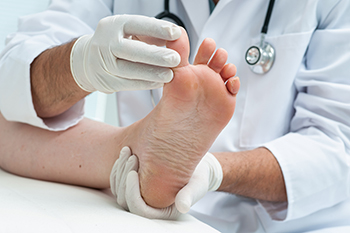
Though its name would imply the skin condition known as athlete’s foot is specific to athletes, that is not the case. Anyone can get this fungal infection. It is said to be more common in specific geographic regions, and tends to impact the elderly who have a weakened immune system or other conditions affecting the lower leg. Athlete’s foot is also referred to as tinea pedis or ringworm of the foot. It is generally characterized by flaking, itching, and a burning sensation between the toes and the skin on the feet. Sometimes the skin will appear to be blistered and may crack. This condition comes from a moist environment combined with a fungus called Trichophyton. Athlete’s foot is highly contagious and can spread through physical contact or from sharing towels, sheets, socks, and shoes. It is an infection that can also spread to the toenails causing them to become discolored, brittle, and ragged. If you believe you have athlete’s foot, it is suggested that you see a podiatrist for a proper diagnosis and treatment.
Athlete’s foot is an inconvenient condition that can be easily reduced with the proper treatment. If you have any concerns about your feet and ankles, contact Dr. John P. Beaupied from Palos Podiatry. Our doctor will treat your foot and ankle needs.
Athlete’s Foot: The Sole Story
Athlete's foot, also known as tinea pedis, can be an extremely contagious foot infection. It is commonly contracted in public changing areas and bathrooms, dormitory style living quarters, around locker rooms and public swimming pools, or anywhere your feet often come into contact with other people.
Solutions to Combat Athlete’s Foot
- Hydrate your feet by using lotion
- Exfoliate
- Buff off nails
- Use of anti-fungal products
- Examine your feet and visit your doctor if any suspicious blisters or cuts develop
Athlete’s foot can cause many irritating symptoms such as dry and flaking skin, itching, and redness. Some more severe symptoms can include bleeding and cracked skin, intense itching and burning, and even pain when walking. In the worst cases, Athlete’s foot can cause blistering as well. Speak to your podiatrist for a better understanding of the different causes of Athlete’s foot, as well as help in determining which treatment options are best for you.
If you have any questions please feel free to contact our office located in Palos Heights, IL . We offer the newest diagnostic and treatment technologies for all your foot and ankle needs.



